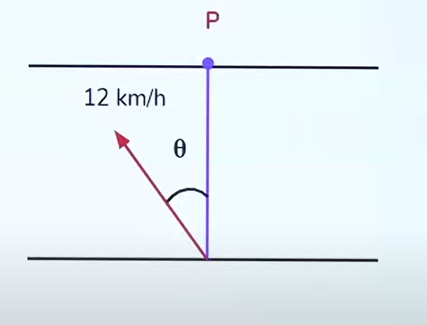A river flows with a speed more than the maximum speed with which a person can swim in still water. He intends to cross the river by the shortest possible path (i.e., he wants to reach the point on the opposite bank which directly opposite to the starting point). Which of the following is correct ?
He should normal to the river bank.
He should start in such a way that he moves normal to the bank, relative to the bank.
He should start in a particular (calculated) direction making an obtuse angle with the direction of water current.
The man cannot cross the river in that way.
The correct Answer is:D
(d) We know that to cross the river by the shortest path,
sin∝=uv
But u>v⇒sin∝>1, which is not possible.
 .
.
Topper's Solved these Questions
- KINEMATICS-2BOOK - CENGAGE PHYSICSCHAPTER - KINEMATICS-2EXERCISE - Exercise Multiple Correct
11 Videos
- KINEMATICS-2BOOK - CENGAGE PHYSICSCHAPTER - KINEMATICS-2EXERCISE - Exercise Assertion - Reasoning
5 Videos
- KINEMATICS-2BOOK - CENGAGE PHYSICSCHAPTER - KINEMATICS-2EXERCISE - Exercise Subjective
40 Videos
- KINEMATICS-1BOOK - CENGAGE PHYSICSCHAPTER - KINEMATICS-1EXERCISE - Integer
9 Videos
- KINETIC THEORY OF GASESBOOK - CENGAGE PHYSICSCHAPTER - KINETIC THEORY OF GASESEXERCISE - Compression
2 Videos
Similar Questions
2 km wide river flowing with a rate of 5 km/hr. A man can swim in the still water with10 km/hr. He wants to cross the river along shortest path find
Crossing time
View SolutionA man can swim at the rate of 5kmh−1 in still water. A 1−km wide river flows at the rate of 3kmh−1 The man wishes to swim across the river directly opposite to the starting point.
(a) Along what direction must the man swim ?
(b) What should be his resultant velocity ?
( c) How much time will he take to cross the river ?
View Solution
Knowledge Check
A river is flowing due east with a speed more than the maximum speed with which a person can swim in still water. He intends to cross the river by shortest possible path. Which of the following is correct?
AHe should start normal to the river bank.BHe should start in such a way that, he moves normal to the bank, relative to the bankCHe should starts in a particular (calculated) direction making an obtuse angle with the direction of water currentDThe man cannot cross the river, in that way.The rowing speed of a man relative to water is 5kmh−1 and the speed of water flow is 3kmh−1. At angle to the river flow should he head if he wants to reach a point on the other bank, directly opposite to starting point ?
A127∘B143∘C120∘D150∘The speed of boat is 5kmh−1 in still water. It crosses a river of width 1 km along the shortest possible path in 15 min. Then, velocity of river will be
A4 km/hrB3 km/hrC2 km/hrD1 km/hr
A man can swim in still water at a speed of 5km/h. Man crosses 1 km width of river along shortest possible path in 15 minutes . What is the speed of river in km/h?
View SolutionA swimmer can swim with speed 12 m/s in still water. Speed of river is 6 m/s. Find angle at which he should swim with downstream so that he reaches directly opposite point on other side

View SolutionA man can row a boat with 4km/h in still water, if he is crossing a river where the current is 2 km/h.
(a) In what direction will his boat be holded, if he wants to reach a point on the other bank, directly opposite to starting point?
(b) If width of the river 4km, how long will the man take to cross the river, with the condition in part (a)?
(c) In what direction shou ld he heat the boat if he wants to cross the river in shorest time and what is this minimum time?
(d) How long will it take him to row 2 km up the stream and then back to his starting point?
View SolutionThe speed of boat is 5kmh−1 in still water. It crosses a river of width 1 km along the shortest possible path in 15 min. Then, velocity of river will be
View SolutionA man can swim in still water with a speed of 2ms−1. If he wants to cross a river of water current speed √3ms−1 along the shortest possible path, then in which direction should he swim ?
View Solution
